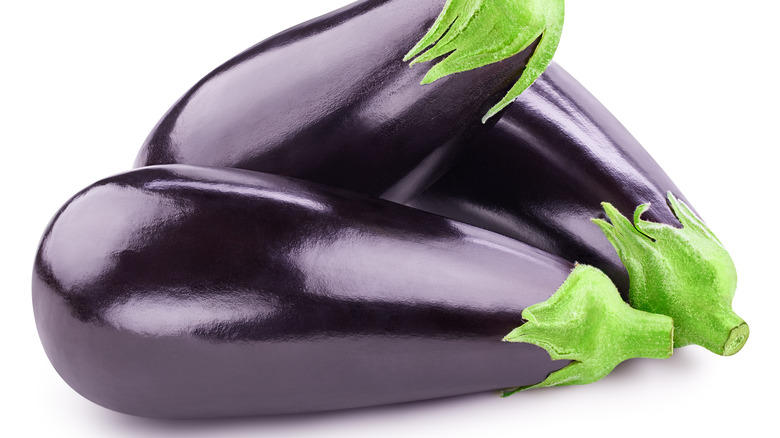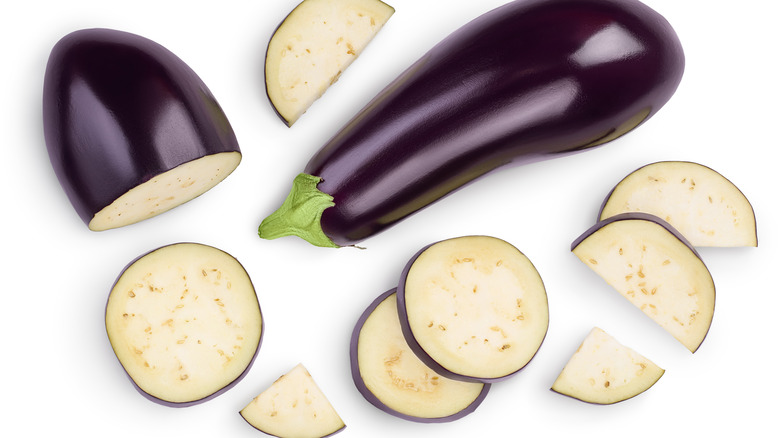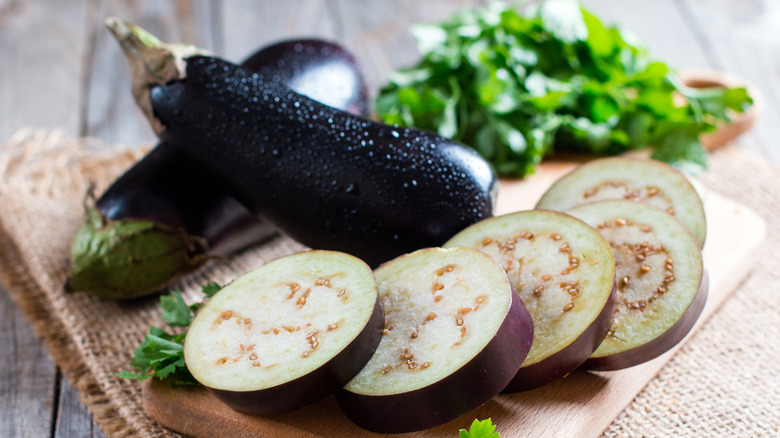How To Tell If Eggplant Has Gone Bad
Here are three reasons for loving eggplant: baba ganoush, eggplant Parmigiana, and moussaka. The list could be longer, of course, as eggplant is one of the most versatile ingredients a kitchen could have. Plus, this nightshade vegetable tastes great whether fried, baked, pureed, covered with mozzarella cheese, or served as part of any vegetarian dish.
Sadly, though, this rich vegetable can go bad quickly, lasting less than a week in the fridge. Eating a bad vegetable is not only an unpleasant experience for any foodie, but it can lead to health problems, as well. Raw vegetables can carry bacteria like salmonella or E. coli and, if eaten unsafely or not cleaned well, cause food-borne sickness, according to the CDC. For cooks, the best advice is to pay attention to the general signs that food has gone bad. In the case of eggplant, the tricks are super simple, mostly involving a scan for any strange markings and using the classic sniff test. Here are foolproof ways to see whether or not eggplant is still safe to eat.
Check the Exterior
Hold your eggplant and take a close look at the exterior's color and texture. A good eggplant should have a deep purple color and a smooth, glossy texture, according to SFGate. The purer the color, the better. It shouldn't have dull skin, mold, or cracks, not even in the stem or cap of the vegetable, which should be a lively green. While vegetables don't always have to look perfect to be edible, any blemishes could be a sign that the food is past its prime on the inside, too.
After checking your eggplant's appearance, you should confirm that the texture is good to go. Start by pressing your finger gently into the eggplant. Is it firm and sturdy? Then it's perfect. Try this a couple of times on different parts of the vegetable. If your finger easily pierces the flesh or the impression remains on the skin, the eggplant is no longer fresh and shouldn't be used in your pasta alla Norma recipe.
Check the Interior
The color and texture of the interior of your eggplant are just as important as those on the exterior, EatingWell reports. When you cut into the vegetable, the white flesh should look bright and fresh, without any wrinkling, dark marks, or mold. The texture should be tender but firm (you can repeat the pressing method with a fork, toothpick, or your finger). If you find any discolored, slimy, or squishy spots, it's probably bad.
One caveat: The interior of an eggplant should preferably be free of dark spots when freshly sliced. However, you may notice the cut pieces getting brownish after a few minutes on your cutting board. According to Allrecipes, this is likely just due to a process called enzymatic browning, when oxygen causes the flesh to darken. If your eggplant is brown in a few places but looks, smells, and feels good otherwise, worry not: It's still good.
Do the Sniff Test
The sniff test is a classic, reliable vegetable-testing method you can try in grocery stores and in your own kitchen. EatingWell describes the ideal eggplant aroma as "earthy" and, of course, fresh. When cut, it should smell like, well, eggplant, giving you cravings for the recipes that come to mind as soon as you hear the word. If the scent is instead unappetizing and rotten, you can trust that the vegetable is bad.
If, after checking your eggplant's exterior, interior, and smell, you find that its quality has gone south, we're sorry! Next time, avoid waste by picking out the freshest eggplant at the store (with dark, glossy skin and a non-squishy texture, per Bon Appétit) and using it as soon as it's ripe. At home, make sure to store it safely and wash it correctly before using it. Then you can bake, fry, or dip to your heart's content.



